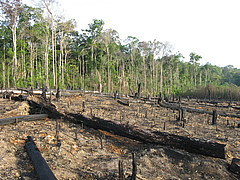Ecosystem Disturbance and the Recovery Debt

The study cautions against pursuing ecosystem management strategies, particularly compensation policies that exclusively rely on restoration or recovery to reverse biodiversity and functional loss, because they will increase the quantity of less-functional and diverse ecosystems. Credit: guentermanaus – Fotolia
Note for the media: Use of the pictures provided by iDiv is permitted for reports related to this media release only, and under the condition that credit is given to the picture originator.
The study illustrates that while restoration is crucial to regaining ecosystem function, protecting ecosystems against human disturbance is ultimately the best way to ensure no interruption in these services. The study cautions against pursuing ecosystem management strategies, particularly compensation policies that exclusively rely on restoration or recovery to reverse biodiversity and functional loss, because they will increase the quantity of less-functional and diverse ecosystems.
The study was supported by the National Socio-Environmental Synthesis Center (SESYNC) under funding received from the National Science Foundation (NSF), by the Helmholtz Centre for Environmental Research (UFZ) and by sDiv, the Synthesis Centre of iDiv. The authors met in May 2014 for the sDiv workshop „Restoration synthesis“ in Leipzig. The results are now published in the journals
Nature Communications and
PLOS ONE.
Read more in the press release of the National Socio-Environmental Synthesis Center (SESYNC) at the University of Maryland:
https://www.sesync.org/news/wed-2017-01-18-1109/new-study-ecosystem-disturbance-and-the-recovery-debtPublications:
David Moreno-Mateos, Edward B. Barbier, Peter C. Jones, Holly P. Jones, James Aronson, José A. López-López, Michelle L. McCrackin, Paula Meli, Daniel Montoya & José M. Rey Benayas (2017): Anthropogenic ecosystem disturbance and the recovery debt. Nature Communications 8, 14163, published online 20 January 2017 (Open), doi:10.1038/ncomms14163
http://dx.doi.org/10.1038/ncomms14163
Meli P, Holl KD, Rey Benayas JM, Jones HP, Jones PC, Montoya D, et al. (2017) A global review of past land use, climate, and active vs. passive restoration effects on forest recovery. PLoS ONE 12(2): e0171368.
http://dx.doi.org/10.1371/journal.pone.0171368Links:
sDiv Workshop „Restoration synthesis“:
https://www.idiv.de/sdiv/working_groups/sesync_ufz_sdiv/restoration_synthesis.html
„A Restoration Synthesis“ at SESYNC:
https://www.sesync.org/project/restoration-synthesis
